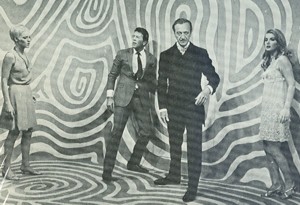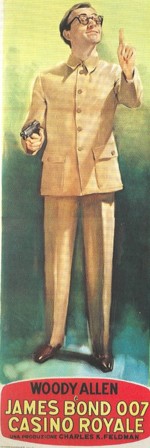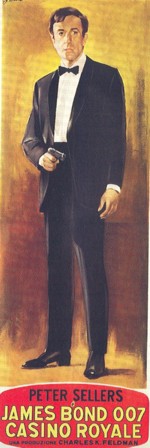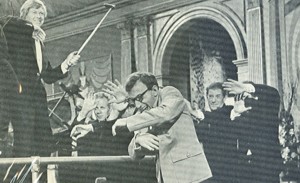| Casino Royale (1967) is a sort of love/hate proposition. On one viewing it can seem fresh and outrageously funny, on another, labored, forced, drawn out. No matter what opinion one may hold about the movie, it is remarkable that it was made at all.
The story begins, of course, with Ian Fleming's novel. The screen rights had been acquired in 1954, the year that the novel made its U.S. debut, and a live television version was broadcast later that year on October 21 with Barry Nelson as Jimmy Bond and Peter Lorre as Le Chiffre. |
 |
When Harry Saltzman and Albert Broccoli bought the rest of the series this was the one that got away (until fairly recently when it was finally brought into the fold). Instead, it fell into the hands of former agent turned producer Charles K. Feldman.
Charles K. Feldman, an enterprising independent producer who knew a good thing when he saw one, wanted in on the Bond phenomenon. After the colossal success of Thunderball (1965), which had box office grosses in the range of James Cameron's Titanic, Feldman thought to jump on his option. He attempted to negotiate a deal that would allow him to produce the film with Saltzman and Broccoli, but they weren't interested. He'd made a deal with United Artists, the distributor that released all of the Bond films, but Saltzman and Broccoli threatened to pull their series if the deal went through. Very quickly, Feldman had a green light from Columbia.
 |
Saltzman and Broccoli, fearing the competition, relented and tried to make a deal but Feldman's terms were too demanding. He was sent on his way.
At Columbia he was given a $5 million budget, quite healthy for the day. Originally, he had intended a more serious film before realizing that the only way to go was with a spoof. He engaged Peter Sellers as 007. Sellers, boosted to international stardom by the Pink Panther films, was a difficult talent to deal with.
He had already developed a habit of arriving late on the set, something that not only wasted money and kept both cast and crew needlessly waiting, but angered co-star Orson Welles, a consummate professional when working on other people's movies.
One day, Welles arranged to have a spotlight hit Sellers when he entered the purposely darkened soundstage. Welles boomed out a welcome and encouraged everyone to give Mr. Sellers a big round of applause. Reportedly, Sellers stood transfixed like a deer in the headlights, then turned and left, never to return. In the final film they are never on screen together in the scenes they share (but stills exist). |
 |
Feldman scrambled to save his investment which had already ballooned over budget. There seemed no solution but to pour more money into the project and hope for the best. When all was said and done the film would credit five directors and three writers (although ten were used) with a cast of about a dozen screen stars and a gaggle of lesser-knowns. Eventually, the film would cost $10.5 million.
The result is a three-ring circus of a film with the kitchen sink and the Frankenstein Monster (Dave Prowse) thrown in. No surprise really given the production history. With so many cooks the story became a silly hodgepodge in which virtually everyone in the movie becomes James Bond. About the only thing that went totally right was the music score by Burt Bacharach, music that still provides listening pleasure 40 years later. At least the film served as some of the inspiration for the Austin Powers films.
The film begins with a cheat. The Bond films are famous for their pre-title action sequences. Casino Royale begins with a pre-title comedy sequence. Bond (Peter Sellers) is met by the French Inspector Mathis. Their meeting takes place in a French kiosk urinal. Mathis and Bond step into the shielded street lavatory, their bodies visible only from about mid-torso up. Mathis says, "These are my credentials." Bond looks down at what we can't see and replies, "They seem to be in order." This double entendre is meant to jump start the hilarity but, like so much of the movie, is merely amusing. Although Sellers appears as Bond at the top of the film, in strict chronological order he doesn't take on the name until halfway into the film.
 |
After Richard Williams' ornately over-the-top credits unreel -- the first letter of each actor's name in a huge, gilt font encrusted with flags, horns and all sort of other bric-a-brac -- the actual story unfolds as we discover a much older, stuttering James Bond (David Niven), a refined, cultivated gentleman enjoying retirement at his palatial estate. M (John Huston) describes Bond life, saying that he listens to and plays Debussy every evening, eats Royal Jelly, and "Let's his intestines down and washes them by hand. Something he learned during his sojourn in Tibet."
Bond does return to the service, otherwise we'd have no movie. He must track down the evil Dr. Noah by destroying card playing Le Chiffre (Orson Welles) and deal SMERSH a crippling financial blow. Part of Bond's plan is to confuse the enemy by renaming all agents 007 James Bond. Ultimately, all roads lead to Casino Royale.
The film sports impressive technical credits. It is well photographed in Panavision and the production design/art direction is top notch, the expansive sets inspired by influences as varied as a |
 |
1960s pop-culture psychedelic sensibility as the German Expressionism of The Cabinet of Dr. Caligari.
The special effects, top flight for the era, range from remote-controlled grouse, exploding trucks, and Indians with teepee parachutes to flying saucers in Trafalgar Square and spectacular miniature building explosions. The editing is a miracle in creating the illusion of cohesion. And the music creates an overlay that gives the entire film a consistency of sorts, like frosting over a layer cake.
But the film remains amusing rather than funny. The first really funny sequence occurs when Jimmy Bond (Woody Allen) appears. He is being led to his death before a firing squad in the Caribbean. In his best Bob Hope mode Allen reels off three or four funny one-liners. "Listen, you can't shoot me. I have a very low threshold of death. My doctor says I can't have bullets enter my body at any time. What if I said I was pregnant?" Allowed a last smoke, Jimmy lights up an exploding cigarette. As it detonates he is already scrambling over the top of the wall yelling, "So long, suckers!" and dropping down the other side. Where another firing squad is at work.
| Allen's moments in the film are the only truly funny moments, informed by that comic sensibility that propelled him into the national limelight as one of the hottest comics of the 1960s. His fumbling efforts to impress Daliah Lavi and his physical ineptitude as an evil leader are the only bright spots in the movie. But even he is swamped by the magnitude of the project as when he proclaims all that he wishes to accomplish by running the world. |
 |
The lights dim and change color, the circular area he stands on rises like a stage exposing several blue-suited singers underneath humming "Glory, Glory Hallelujah." The moment the lift has reached its maximum height it immediately lowers again.
Some pleasure can be taken in the performances of the supporting cast. Ronnie Corbett, perhaps best known for the British TV show The Two Ronnies, plays little Polo, besotted with love for Mata Hari and now her daughter Mata (Joanna Pettet). It's fun to watch Orson Welles pretend to perform magic illusions, an indulgent nod to Welles actual interest in and performances of prestidigitation. It's good to see Bernard Cribbins, who later had an hilarious turn as an angry hotel guest in an episode of Fawlty Towers, get to be an action hero.
Percy Herbert, Colin Gordon, Geoffrey Bayldon, John LeMesurier, and Derek Nimmo, stalwart British character actors, all get short but effective moments. Graham Stark and Burt Kwouk, both veterans of the Peter Sellers' Pink Panther films also appear. Vladek Sheybal, who played chess champ Kronsteen in From Russia With Love, has a nice bit as Le Chiffre's auctioneer. Even the totally pointless cameos by George Raft, Peter O'Toole and Jean-Paul Belmondo are enjoyable. Jacky (Jacqueline) Bisset is also seen to good advantage as Miss Goodthighs.
But much of what humor exists is in the small throwaways such as a badly beaten spy at the James Bond Training Center being offered sugar with his tea and his request for "Two lumps." Elsewhere, Sheybal is blown to pieces in a phone booth outside the Berlin Wall. Before the smoke clears, refugees are pouring through the hole as if they'd been waiting there all along. Later, Le Chiffre's assassin reaches him by literally breaking out of a TV monitor. It's a Mad magazine sensibility, more of which would have been welcome.
Surprisingly, there actually are remnants of the original novel present. Fleming's book was primarily about a plot to destroy Le Chiffre at the card table. The amount cited was 50 million francs. Le Chiffre was defeated in the casino and later assassinated. Bond's French contact was named Mathis. Vesper Lynd was Bond's teammate, was kidnapped and did betray him. In the torture scene the novel is referenced by having a chair with no bottom and the rug beater that juts from the side of the chair.
Casino Royale isn't a truly bad movie, merely a mediocre film. That it contains entertainment value can be largely attributed to its time capsule aspect, a mammoth train wreck of a production freezing in time on celluloid a cinematic party the likes of which isn't likely to occur again.
Return to:
|






